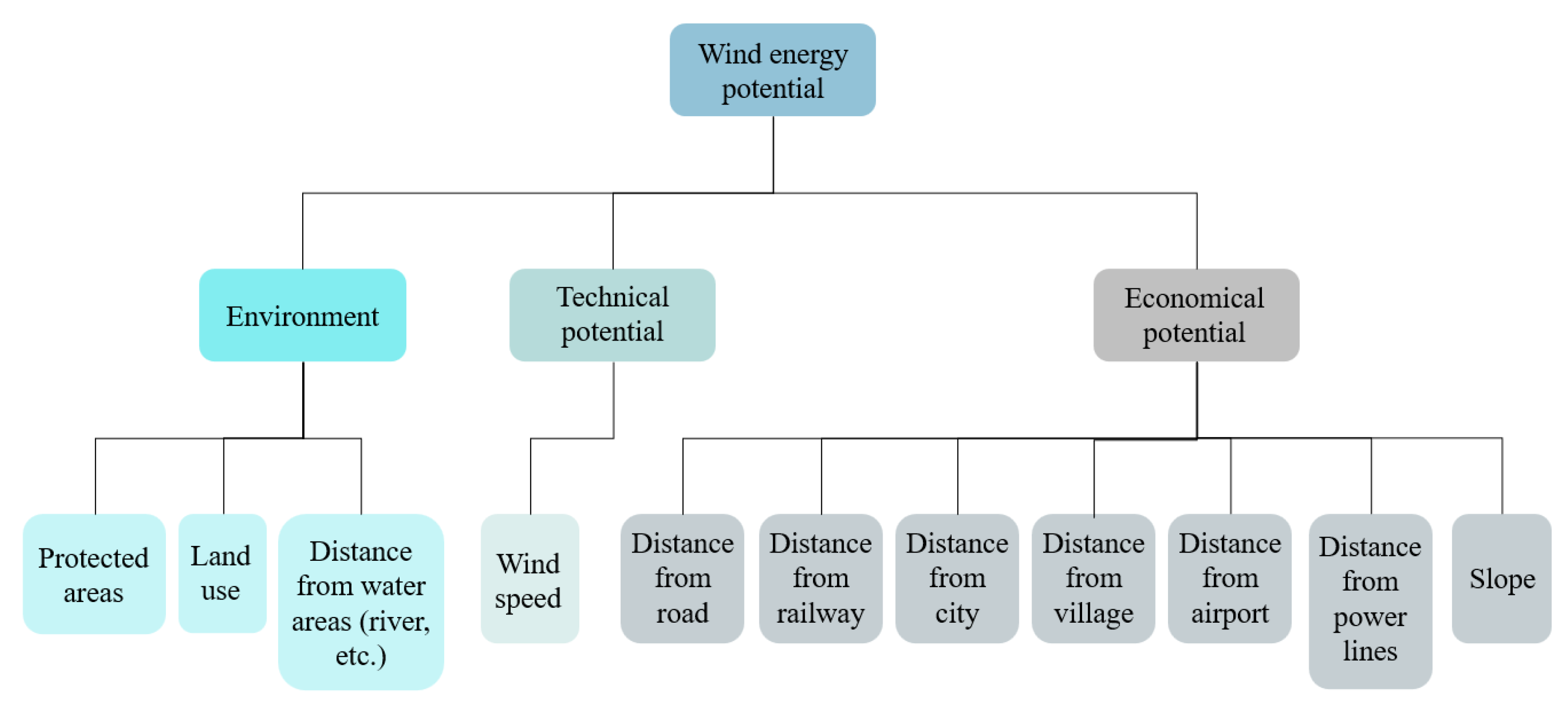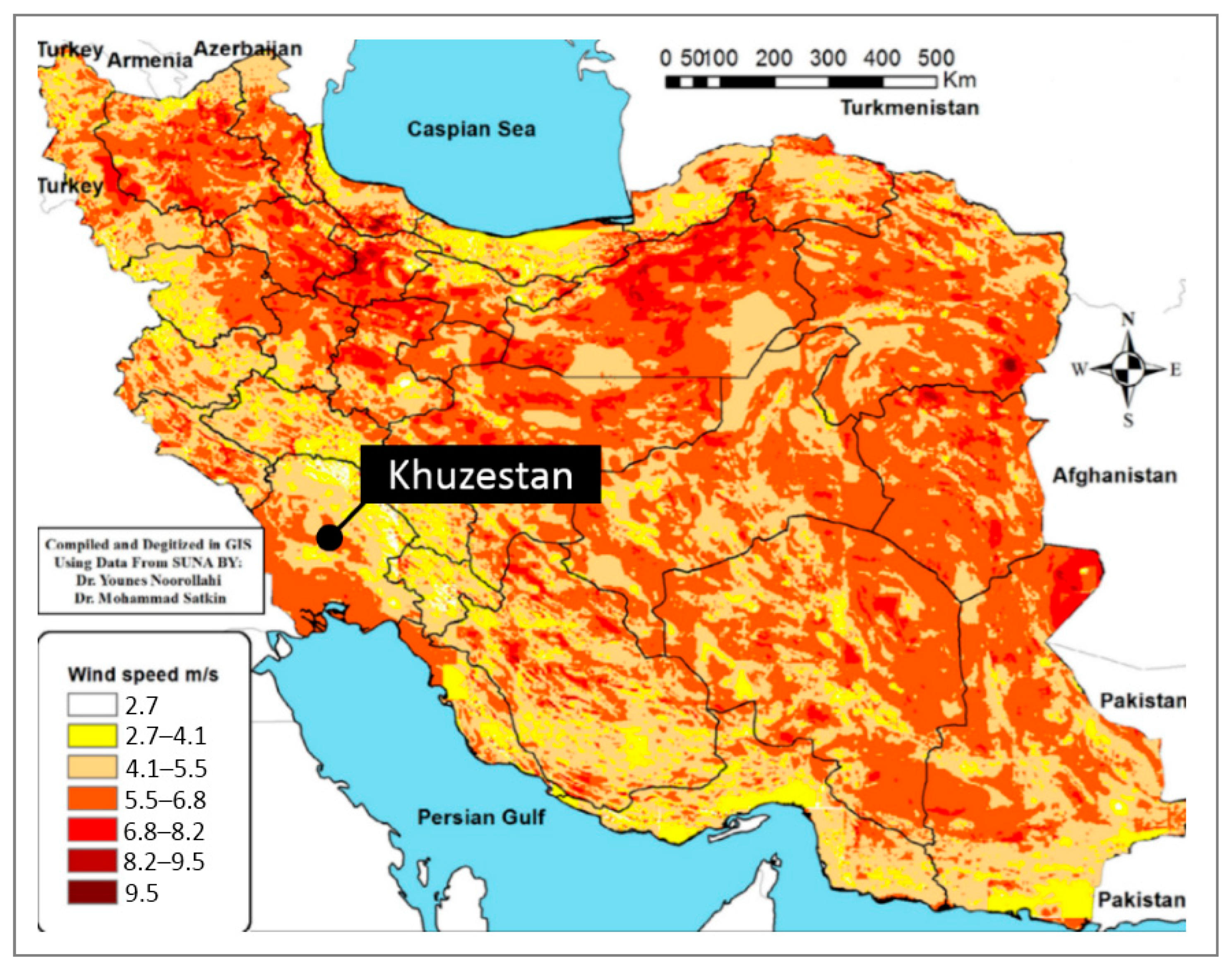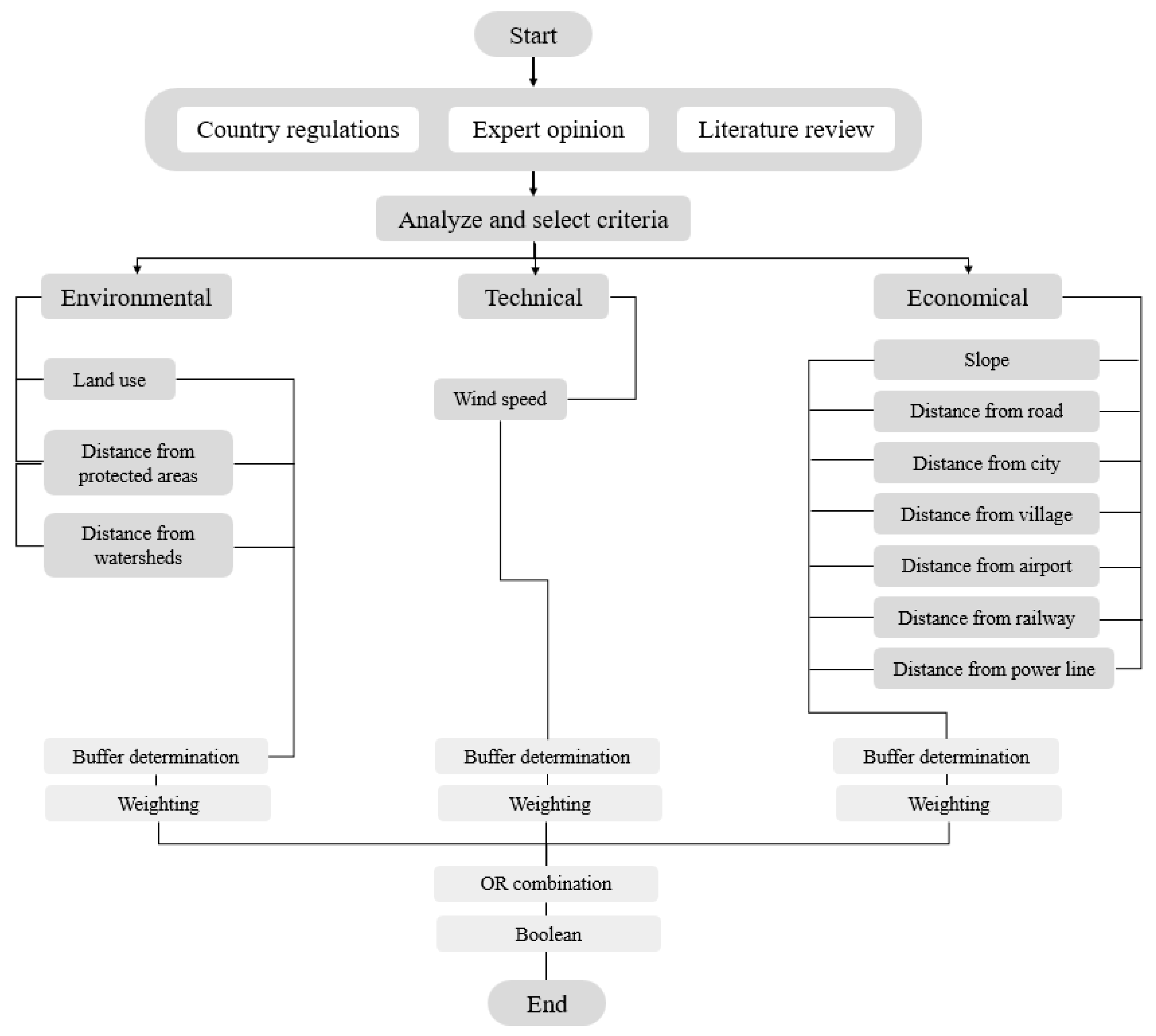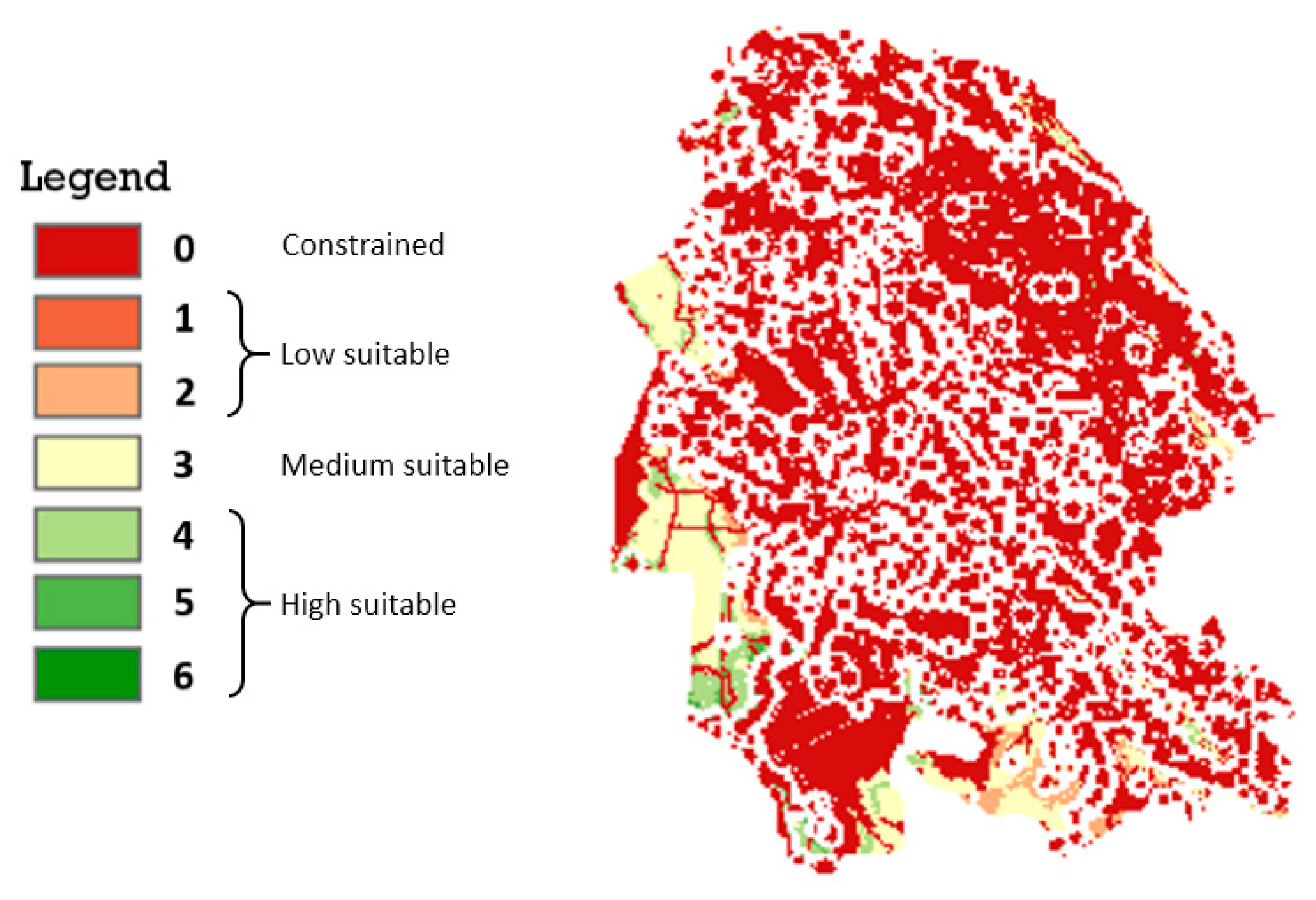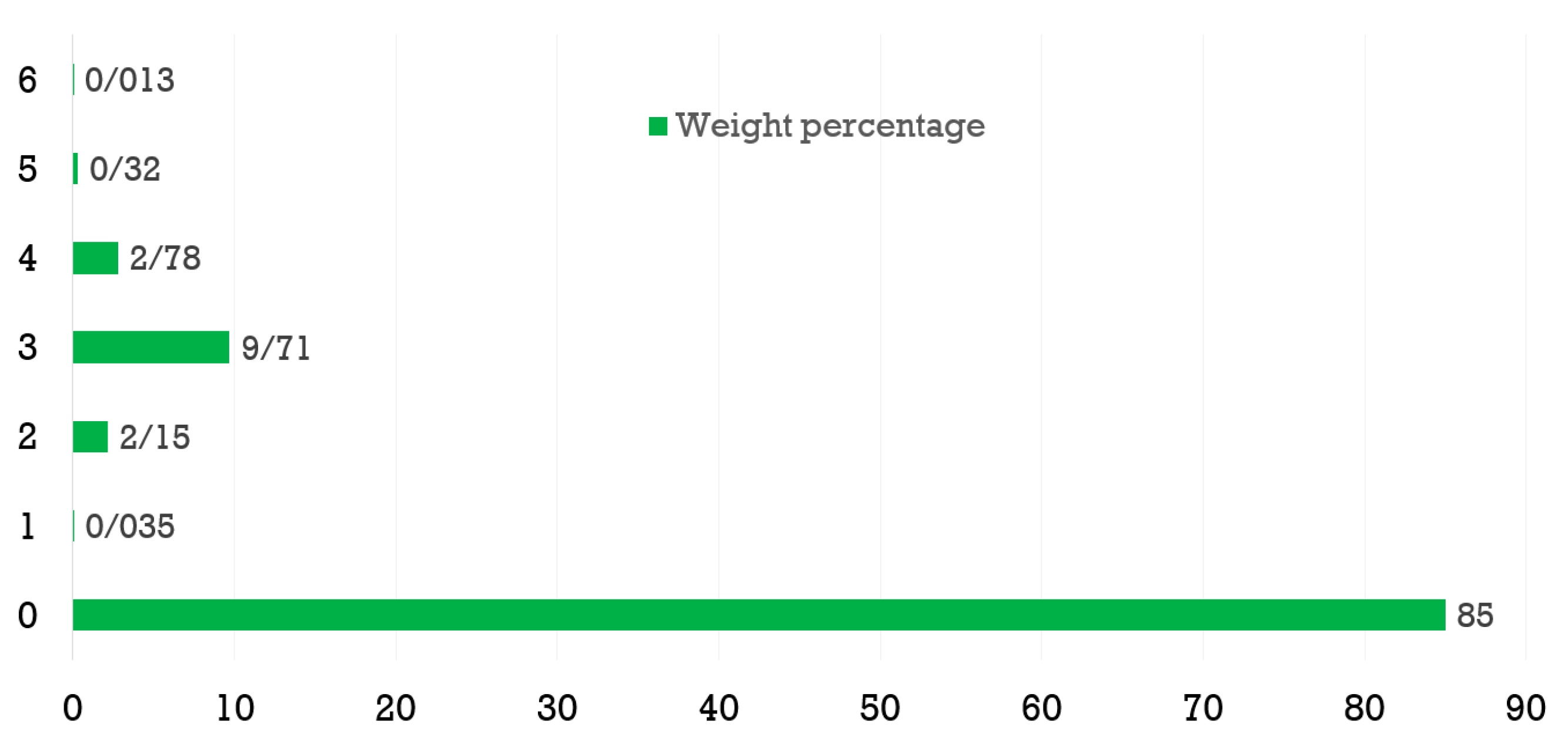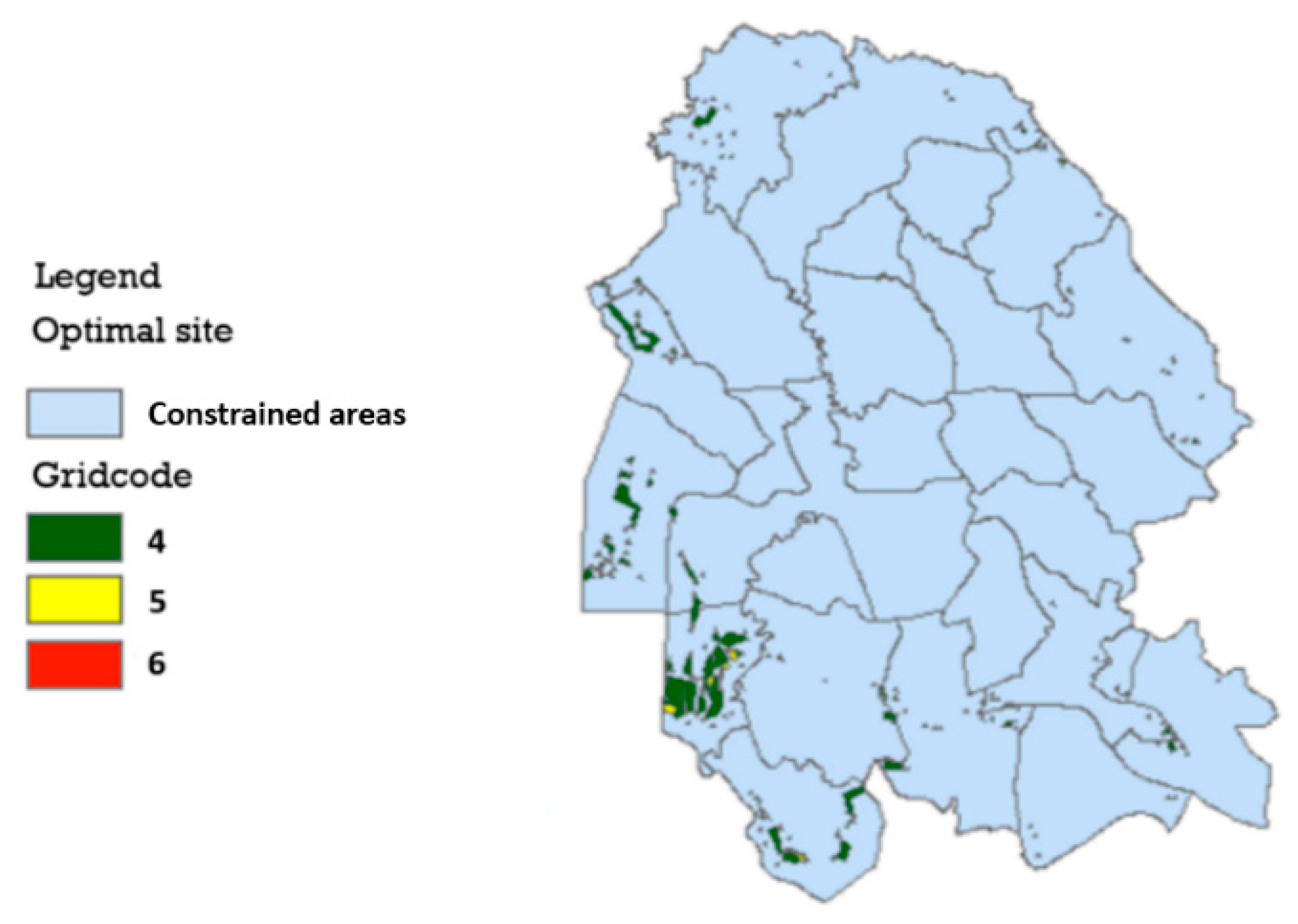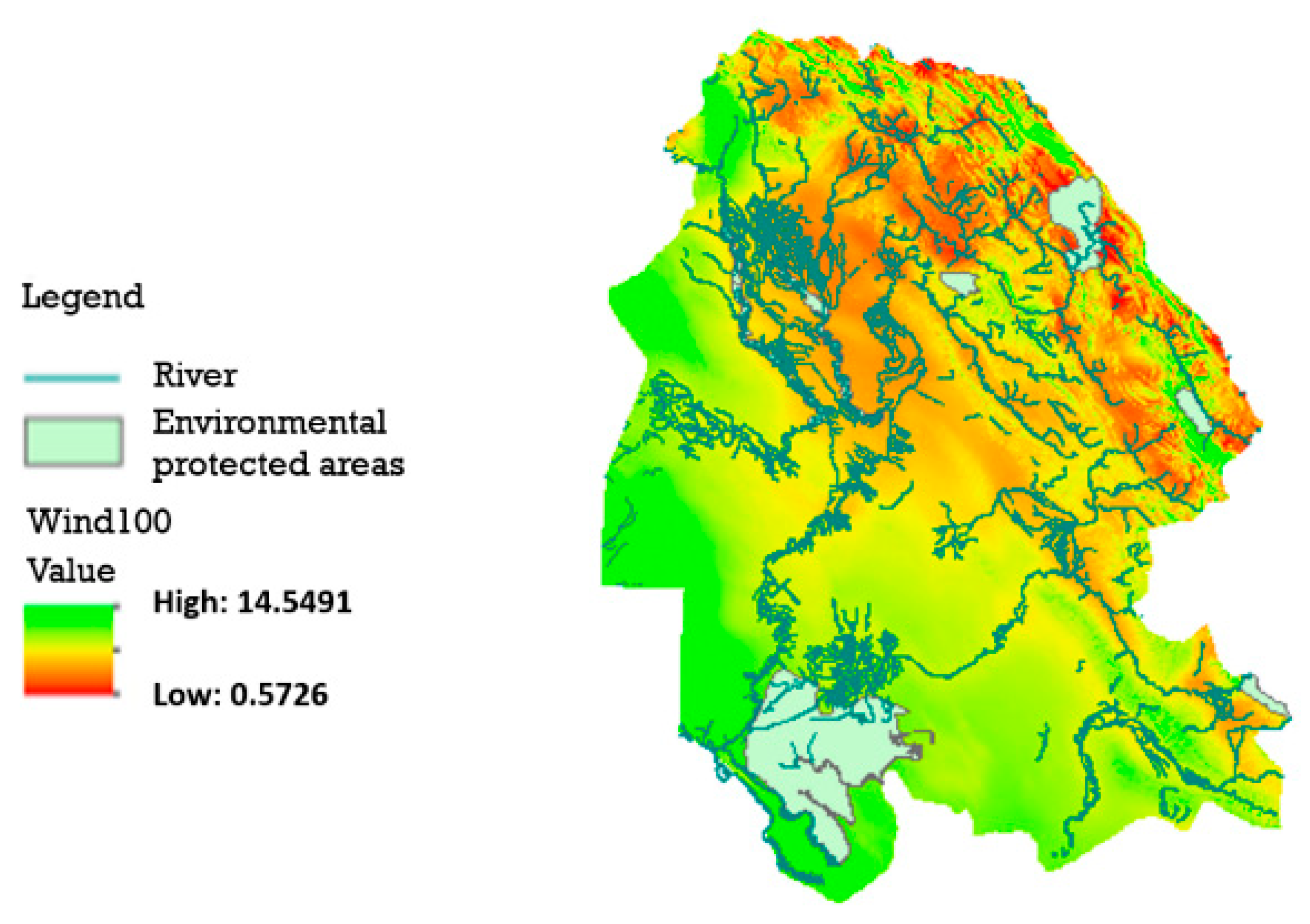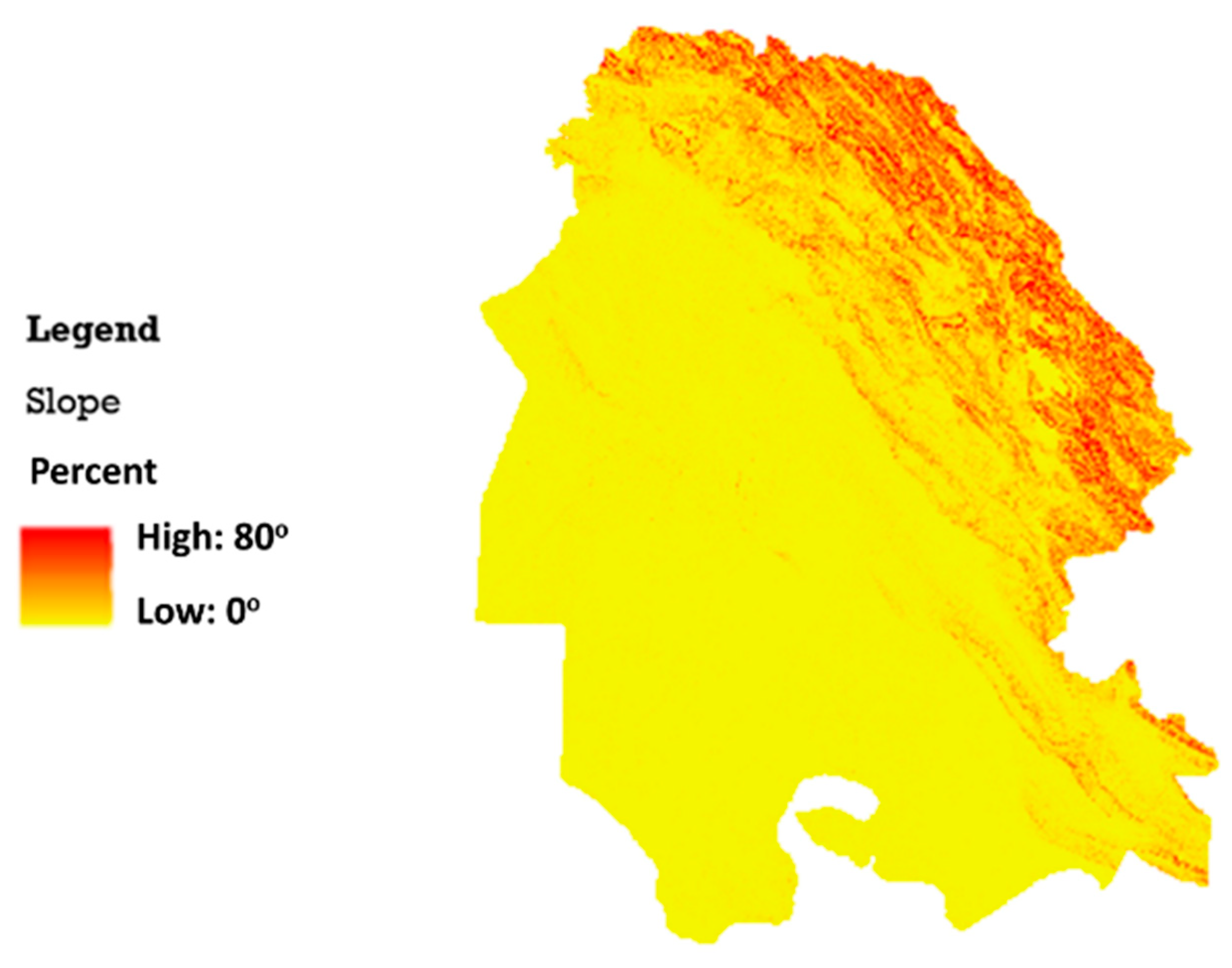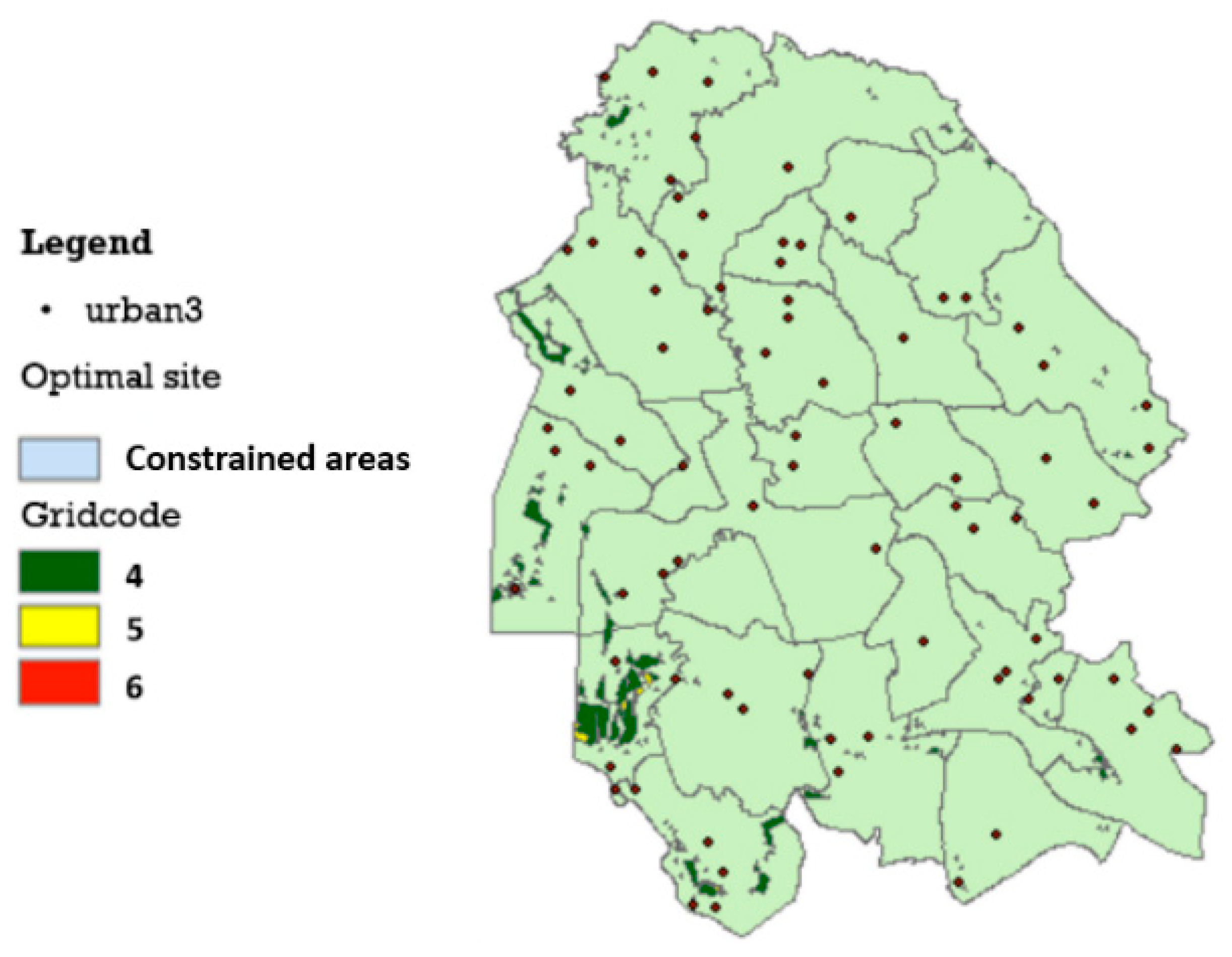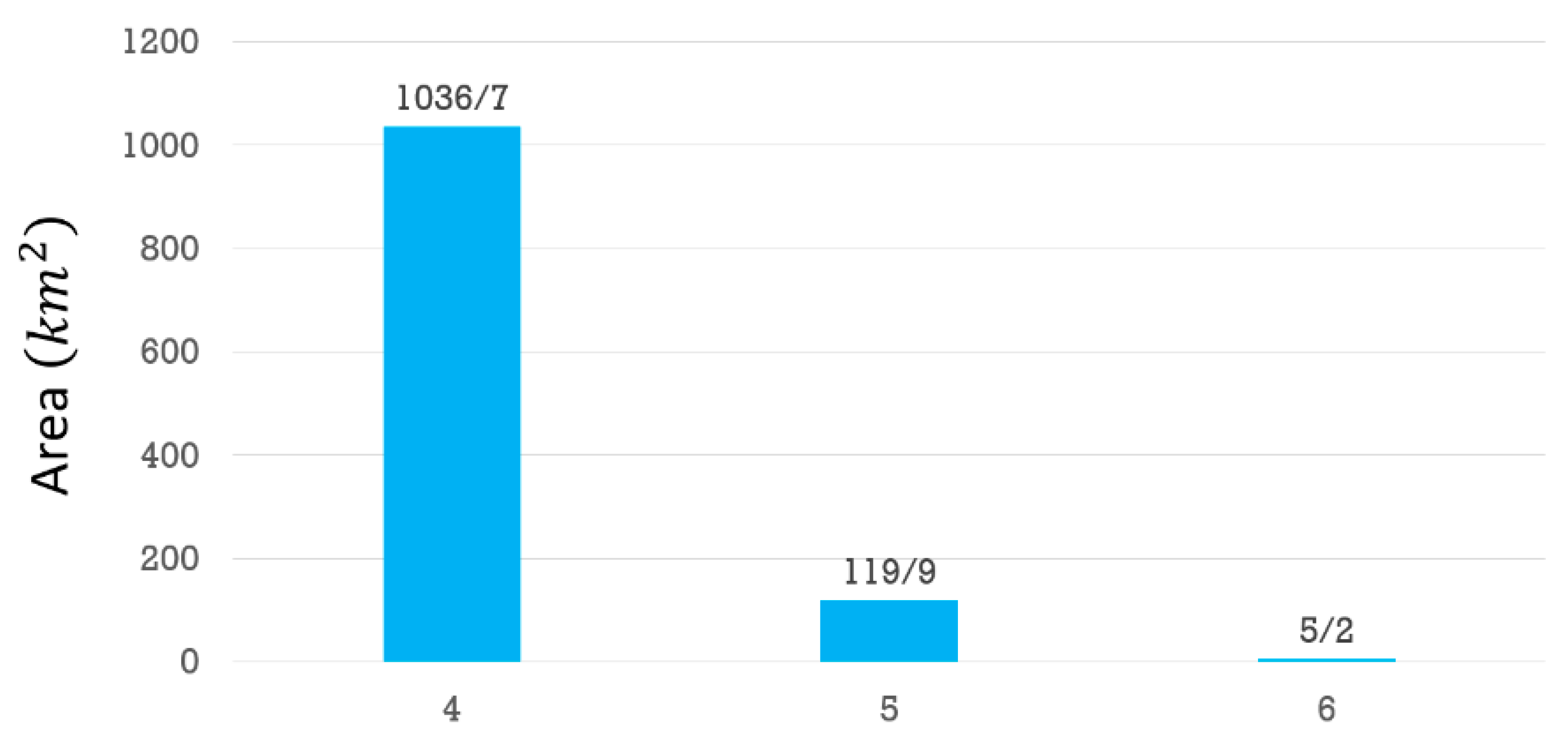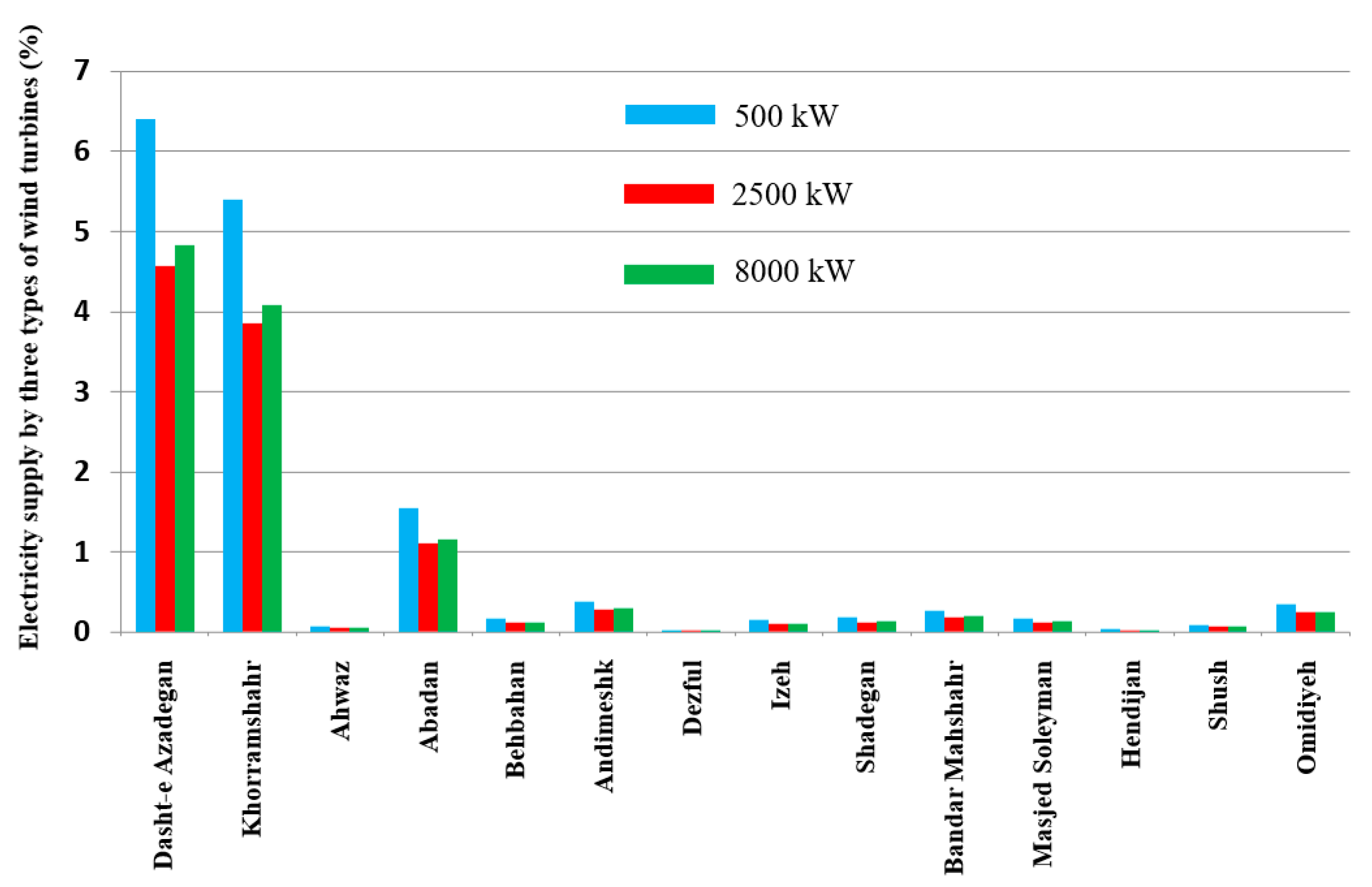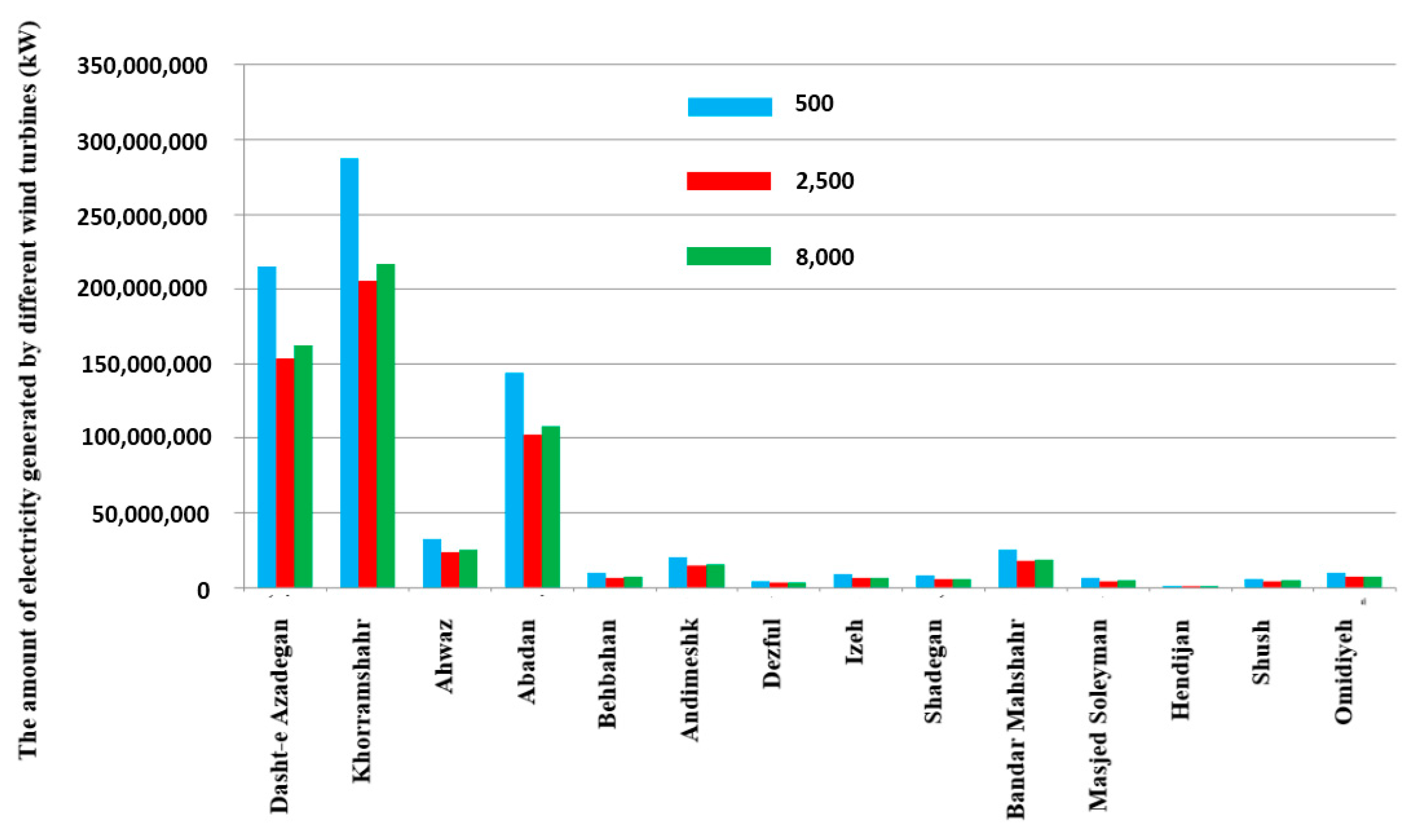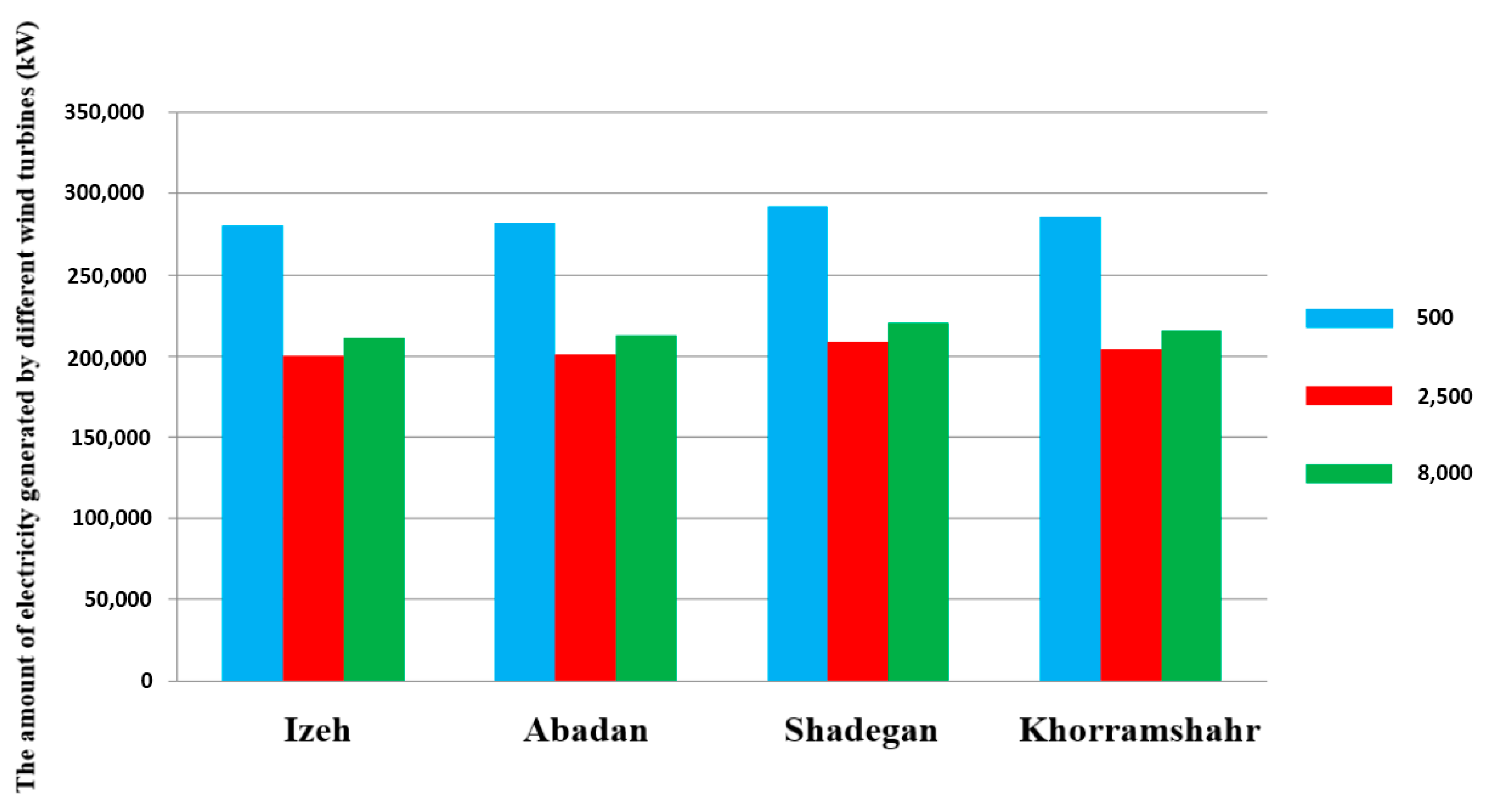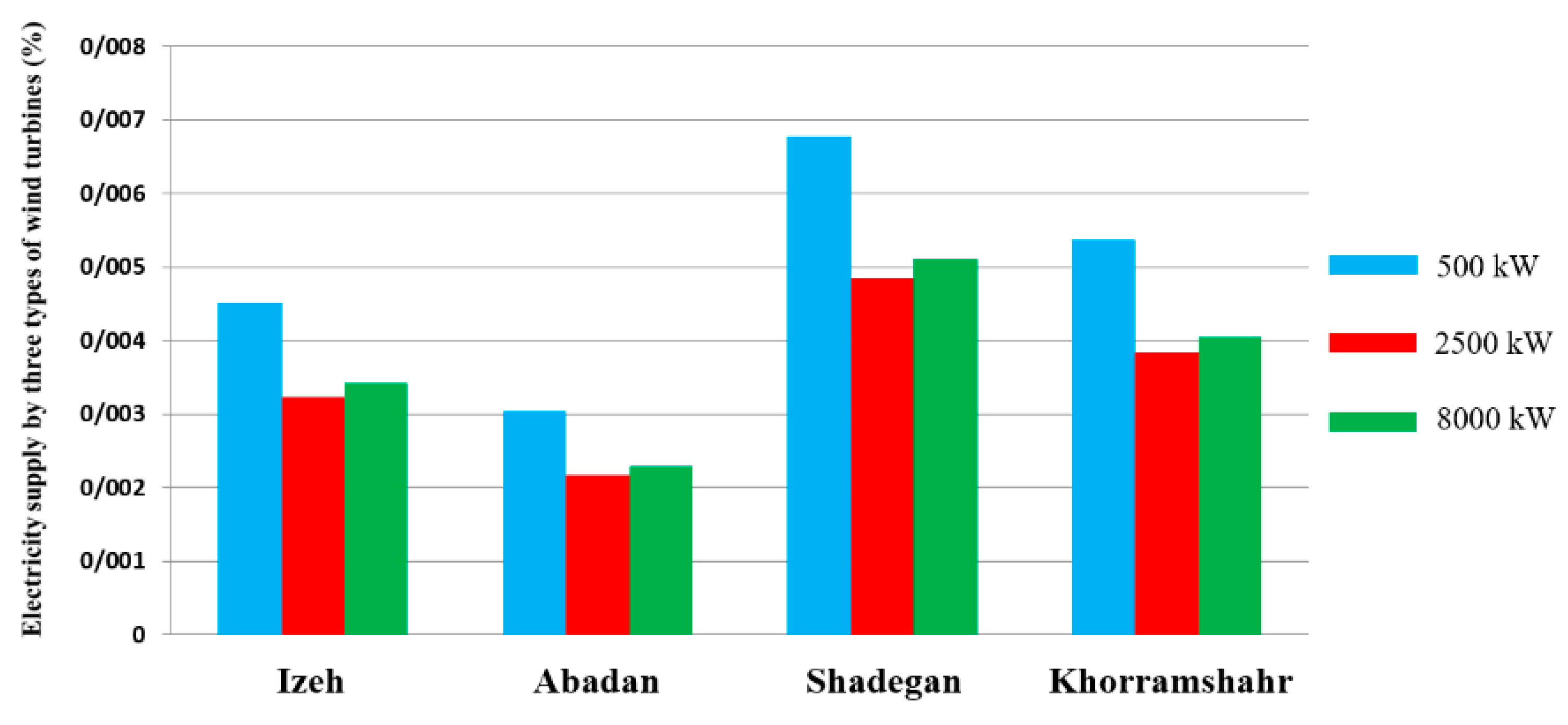3.1. Case Study
The use of wind energy in Iran first started with the installation of two 500 kW wind farms in the Manjil and Rudbar regions in 1994; the average wind speed in the area near the Rudbar River was 15 m per s for 3700 h per year and also 13 m per s for 3400 h per year in Manjil region [
35,
36]. Currently, the capacity of wind farms in Manjil and Rudbar is 92.5 MW. In addition, a wind farm has been constructed in the Binalood mountain region in Khorasan province, which is in northeastern Iran, and the wind speed in this region is 9.8 m per s [
35,
36]. This hydro-plant has 45 wind turbines with a total capacity of 28.6 MW. We can also mention the wind farm constructed in the Zabol region in southeastern Iran, Shiraz in central Iran, Tabriz in the northwest, Takestan in the west, and Mahshahr in southern Iran. The capacity of all these wind turbines is in the range of 660–747 kW [
36,
37,
38]. According to the wind atlas of Iran and considering the technical and economic potential of wind energy, it is estimated that the potential to generate electricity using wind energy in the country is about 15,000 MW [
37,
38,
39].
Figure 2 shows a map of Iranian wind speed at 80 m.
Khuzestan province, with an area of 236.64 square km, between 47 degrees and 41 min to 50 degrees and 39 min east longitude of the Greenwich meridian and 29 degrees and 58 min to 33 degrees and 4 min north latitude of the equator, is located in southwestern Iran. This province borders Ilam province to the northwest, Lorestan province to the north, Chaharmahal-e-Bakhtiari, Kohgiluyeh, and Boyer-Ahmar provinces to the northeast and east, the Persian Gulf to the south, and Iraq to the west. According to the country’s division in 1375, this province has 15 cities, 35 districts, 13 villages, and 4496 settlements. Ahvaz is the capital of Khuzestan province. The population of this province is about 4.7 million people (2016), which is the fifth most populous province of Iran. Khuzestan province is surrounded by the Zagros Mountains to the north and east. Towards the province’s center, the sea level decreases, and flat plains replace the high mountains. Khuzestan includes two mountainous and plain regions. Two-fifths of the total area of this province is mountainous, and three-fifths is plains. Kuh-e Chu, Zardkooh, Shavish, Abbandan, Mamazad, Kuh-e Siah, and Kuh-e Chal are among the mountains of Khuzestan. Khuzestan plain has a slight slope, and in some parts, there are salt domes that play a major role in the salinization of the land and water.
Khuzestan is the most water-rich province of Iran. The five great rivers that originate from the Zagros irrigate the plains of Khuzestan and flow directly or indirectly into the Persian Gulf. Karun, the largest of these rivers, is the largest river in Iran, which originates from the Central Zagros mountains and joins the waters of Dez near Shushtar. Khuzestan province has different climates: a semi-desert climate that includes the cities of Abadan, Khorramshahr, Mahshahr, Hindijan, Azadegan plain, Dezful, Behbahan, Ramhormoz, Shushtar, and the northern regions of Ahvaz. The hot steppe climate includes the northern regions of Dezful, Behbahan, Ramhormoz, Shushtar, and northern Ahvaz. Khuzestan province is affected by three types of winds: the first wind is the cold flow of mountainous areas, and the second wind (sultry) is the hot and humid flow of the Persian Gulf that blows towards the plains. The third wind blows from Saudi Arabia and always brings some sand and moisture. Based on the data of synoptic stations in Khuzestan province in 1375, an absolute minimum temperature of −0.2 °C and an absolute maximum temperature of 40.50 °C were reported in Ahvaz.
3.2. Selecting the Site of the Wind Farm
A GIS is “a computer-based system that can hold and use data describing surface locations of the earth” [
41,
42]. It is a tool that is widely used for decision making in various fields such as urban management, transportation planning, environmental management, telecommunications, service planning, national defense, network management, and marketing [
43,
44]. The methodology proposed is simple and provides rapid and accurate results at a low cost [
45]. Depending on which person or organization uses this program, the definition and scope of its usage changes [
46]. In a nutshell, this program is a combination of hardware, software, and procedure to facilitate management, analysis, and modeling to solve complex planning problems [
47]. The main purpose of a GIS is to preserve geographical space data [
44]. This program allows organized geographic data to be integrated with other data, and, as a result, a new series of data and useful information for decision making are created. One of the basic features of a GIS is data layers, which represent different characteristics in a specific area, allow the creation of specific criterion for each layer, and overlap all layers to produce an optimal area that meets all criteria. Therefore, it is widely used in site selection problems for various purposes [
43].
Selecting a site for a large wind turbine requires the consideration of a comprehensive set of factors and a balance of several objectives. The selection of suitable project areas involves factors such as physical, demographic, economic, policy, and environmental factors. The selection criteria must also meet the optimistic criteria.
The Multi-Criteria Decision Making (MCDM) technique is adopted in different approaches to decision making. This method includes explicit statements of the decision maker’s preferences. These preferences are represented by different values, scales, constraints, purposes, tools, and other parameters. They analyze and support the decision through a formal analysis of alternatives, their characteristics, evaluation criteria, objectives, and constraints. The multi-criteria decision method is used to solve various site selection problems.
The most important factor in the multi-criteria decision method is determining the “weight” of a set of criteria according to their importance. The Analytic Hierarchy Process (AHP) is a comprehensive, logical, and structural framework that allows the analyst to understand complex decisions by analyzing the problem in a hierarchical structure. Combining all the relevant decision criteria and comparing them in pairs allows the decision maker to determine the transactions between the objectives. The AHP allows decision makers to represent a complex problem in a hierarchical structure that illustrates the relationship of purpose, goals, criteria, and options.
3.3. Evaluation Process
The evaluation methodology is mainly based on three sources: country regulations, opinions of experts in this field, and findings from the literature reviews.
Figure 3 shows the algorithm for this evaluation.
Wind speed: this is the most important factor in the selection of a site for a wind farm. There is a limitation for maximum and minimum wind speed, which is specified by the turbine manufacturer. The usual minimum and maximum wind speeds for current technologies with turbines are 6 and 25 m per s [
48].
Slope: The land’s slope is also one of the main factors for the proper operation of wind turbines and their installation. Slope affects the amount of power extracted from the turbine [
48]. By increasing the slope of the land, the cost of building a wind farm increases. Therefore, the slope should be reasonable, which in this study is considered a maximum slope of 30%. The slope is calculated based on the province’s digital elevation model.
Distance from city and village: A suitable distance from population centers is important: (1) Noise pollution of wind turbines; (2) Reduced wind speed: Small-scale artificial environments lead to climate change, which may cause up to 25% reduction in average wind speed in the installation areas; (3) Development of future residential sectors; (4) Financial costs [
49]; (5) Providing the required human resources at the location of the turbine.
Distance from rivers, lakes, and dams: Since the route of rivers is constantly changing and floods are likely to occur, the distance of wind farms from the riverbed increases the security of facilities [
49].
Distance from routes: According to the regulations of each country, there is a standard distance from roads, which in Iran is 150 m. however, being close to transportation routes is economically important.
Distance from the airport: Wind turbines can interfere with the operation of air traffic control radars. In a radar system, aircraft are detected and tracked by changing the frequency of the return signal (Doppler Effect). Although the Doppler effect does not follow the position of wind turbines due to the absence of change, the orbit and rotation of the turbine wings cause the Doppler effect, which leads to the creation of interferences in tracking and disruption in aircraft identification [
50].
Distance from environmentally protected areas: Wind farms hurt the inherent nature of these areas due to changes in natural landscapes and the creation of noise pollution. For this reason, wind turbines should be located at a suitable distance from protected areas.
Land use: It is not allowed to create a wind farm in specific environments, such as forests, lakes, and urban areas, to prevent any environmental damage.
To find suitable sites for wind farm installation, there are fourteen layers of input spatial data to overlap in ArcGIS 10.8 with GIS extension modules. Details of the input data are shown in
Table 2.
Constraints can be due to topographic factors that affect land usage planning; important factors related to topography include altitude and steep slopes. According to experts’ ideas, installing wind farms in areas with high slopes, such as mountains and cliffs, increases investment. In addition to topographic factors, the country’s rules and land use also create restrictions, for example, installation in residential and urban areas, and installation near rivers, airports, etc., all of which are required by law to have a standard distance. Once the constraints are determined based on Boolean logic, the CON tool is used to assign a true or false value (zero and one), and all areas covered by the restrictions are removed in the last step of the data analysis. These areas and their limitations are shown in
Table 3.
Each criterion is divided into relevant options using the AHP method, and its weight is calculated. First, the hierarchy structure of the criteria is formed according to the AHP method. Then, according to the degree of importance of the criteria to each other, the pairs of factors were compared at each level, and, finally, the weights were calculated. Weighting scores for each criterion are obtained using an AHP. These weights are mostly obtained according to the conditions of the country and region under study. In this research, the highest weight is given to the wind speed, and the lowest is given to the distance from the main and secondary rivers. The weights of the layers are shown in
Table 4.
Valuation for each GIS data layer depends on its importance and appropriateness. The values and points of each layer, according to their unique characteristics and conditions prevailing in the province and the opinions of experts, are shown in
Table 5.
